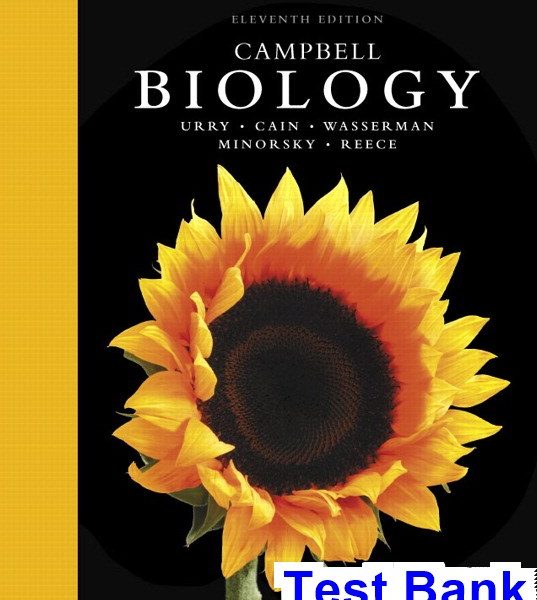Campbell Biology 11th Edition Urry Test Bank
$35.00 Original price was: $35.00.$26.50Current price is: $26.50.
Campbell Biology 11th Edition Urry Test Bank
Campbell Biology 11th Edition Urry Test Bank

Product details:
- ISBN-10 : 0134093410
- ISBN-13 : 978-0134093413
- Author: Neil A. Campbell
The Eleventh Edition of the best-selling Campbell BIOLOGY sets students on the path to success in biology through its clear and engaging narrative, superior skills instruction, innovative use of art and photos, and fully integrated media resources to enhance teaching and learning.
To engage learners in developing a deeper understanding of biology, the Eleventh Edition challenges them to apply their knowledge and skills to a variety of new hands-on activities and exercises in the text and online. Content updates throughout the text reflect rapidly evolving research, and new learning tools include Problem-Solving Exercises, Visualizing Figures, Visual Skills Questions, and more.
Table contents:
1 Evolution, the Themes of Biology, and Scientific Inquiry
Inquiring About Life
CONCEPT 1.1 The study of life reveals common themes
CONCEPT 1.2 The Core Theme: Evolution accounts for the unity and diversity of life
CONCEPT 1.3 In studying nature, scientists make observations and form and test hypotheses
CONCEPT 1.4 Science benefits from a cooperative approach and diverse viewpoints
UNIT 1 THE CHEMISTRY OF LIFE
2 The Chemical Context of Life
A Chemical Connection to Biology
CONCEPT 2.1 Matter consists of chemical elements in pure form and in combinations called compounds
CONCEPT 2.2 An element’s properties depend on the structure of its atoms
CONCEPT 2.3 The formation and function of molecules depend on chemical bonding between atoms
CONCEPT 2.4 Chemical reactions make and break chemical bonds
3 Water and Life
The Molecule That Supports All of Life
CONCEPT 3.1 Polar covalent bonds in water molecules result in hydrogen bonding
CONCEPT 3.2 Four emergent properties of water contribute to Earth’s suitability for life
CONCEPT 3.3 Acidic and basic conditions affect living organisms
4 Carbon and the Molecular Diversity of Life
Carbon: The Backbone of Life
CONCEPT 4.1 Organic chemistry is the study of carbon compounds
CONCEPT 4.2 Carbon atoms can form diverse molecules by bonding to four other atoms
CONCEPT 4.3 A few chemical groups are key to molecular function
5 The Structure and Function of Large Biological Molecules
The Molecules of Life
CONCEPT 5.1 Macromolecules are polymers, built from monomers
CONCEPT 5.2 Carbohydrates serve as fuel and building material
CONCEPT 5.3 Lipids are a diverse group of hydrophobic molecules
CONCEPT 5.4 Proteins include a diversity of structures, resulting in a wide range of functions
CONCEPT 5.5 Nucleic acids store, transmit, and help express hereditary information
CONCEPT 5.6 Genomics and proteomics have transformed biological inquiry and applications
UNIT 2 THE CELL
6 A Tour of the Cell
The Fundamental Units of Life
CONCEPT 6.1 Biologists use microscopes and biochemistry to study cells
CONCEPT 6.2 Eukaryotic cells have internal membranes that compartmentalize their functions
CONCEPT 6.3 The eukaryotic cell’s genetic instructions are housed in the nucleus and carried out by the ribosomes
CONCEPT 6.4 The endomembrane system regulates protein traffic and performs metabolic functions
CONCEPT 6.5 Mitochondria and chloroplasts change energy from one form to another
CONCEPT 6.6 The cytoskeleton is a network of fibers that organizes structures and activities in the cell
CONCEPT 6.7 Extracellular components and connections between cells help coordinate cellular activities
CONCEPT 6.8 A cell is greater than the sum of its parts
7 Membrane Structure and Function
Life at the Edge
CONCEPT 7.1 Cellular membranes are fluid mosaics of lipids and proteins
CONCEPT 7.2 Membrane structure results in selective permeability
CONCEPT 7.3 Passive transport is diffusion of a substance across a membrane with no energy investment
CONCEPT 7.4 Active transport uses energy to move solutes against their gradients
CONCEPT 7.5 Bulk transport across the plasma membrane occurs by exocytosis and endocytosis
8 An Introduction to Metabolism
The Energy of Life
CONCEPT 8.1 An organism’s metabolism transforms matter and energy, subject to the laws of thermodynamics
CONCEPT 8.2 The free-energy change of a reaction tells us whether or not the reaction occurs spontaneously
CONCEPT 8.3 ATP powers cellular work by coupling exergonic reactions to endergonic reactions
CONCEPT 8.4 Enzymes speed up metabolic reactions by lowering energy barriers
CONCEPT 8.5 Regulation of enzyme activity helps control metabolism
9 Cellular Respiration and Fermentation
Life Is Work
CONCEPT 9.1 Catabolic pathways yield energy by oxidizing organic fuels
CONCEPT 9.2 Glycolysis harvests chemical energy by oxidizing glucose to pyruvate
CONCEPT 9.3 After pyruvate is oxidized, the citric acid cycle completes the energy-yielding oxidation of organic molecules
CONCEPT 9.4 During oxidative phosphorylation, chemiosmosis couples electron transport to ATP synthesis
CONCEPT 9.5 Fermentation and anaerobic respiration enable cells to produce ATP without the use of oxygen
CONCEPT 9.6 Glycolysis and the citric acid cycle connect to many other metabolic pathways
10 Photosynthesis
The Process That Feeds the Biosphere
CONCEPT 10.1 Photosynthesis converts light energy to the chemical energy of food
CONCEPT 10.2 The light reactions convert solar energy to the chemical energy of ATP and NADPH
CONCEPT 10.3 The Calvin cycle uses the chemical energy of ATP and NADPH to reduce CO2 to sugar
CONCEPT 10.4 Alternative mechanisms of carbon fixation have evolved in hot, arid climates
CONCEPT 10.5Life depends on photosynthesis
11 Cell Communication
Cellular Messaging
CONCEPT 11.1 External signals are converted to responses within the cell
CONCEPT 11.2 Reception: A signaling molecule binds to a receptor protein, causing it to change shape
CONCEPT 11.3 Transduction: Cascades of molecular interactions relay signals from receptors to target molecules in the cell
CONCEPT 11.4 Response: Cell signaling leads to regulation of transcription or cytoplasmic activities
CONCEPT 11.5 Apoptosis integrates multiple cell-signaling pathways
12 The Cell Cycle
The Key Roles of Cell Division
CONCEPT 12.1 Most cell division results in genetically identical daughter cells
CONCEPT 12.2 The mitotic phase alternates with interphase in the cell cycle
CONCEPT 12.3 The eukaryotic cell cycle is regulated by a molecular control system
UNIT 3 GENETICS
13 Meiosis and Sexual Life Cycles
Variations on a Theme
CONCEPT 13.1 Offspring acquire genes from parents by inheriting chromosomes
CONCEPT 13.2 Fertilization and meiosis alternate in sexual life cycles
CONCEPT 13.3 Meiosis reduces the number of chromosome sets from diploid to haploid
CONCEPT 13.4 Genetic variation produced in sexual life cycles contributes to evolution
14 Mendel and the Gene Idea
Drawing from the Deck of Genes
CONCEPT 14.1 Mendel used the scientific approach to identify two laws of inheritance
CONCEPT 14.2 Probability laws govern Mendelian inheritance
CONCEPT 14.3 Inheritance patterns are often more complex than predicted by simple Mendelian genetics
CONCEPT 14.4 Many human traits follow Mendelian patterns of inheritance
15 The Chromosomal Basis of Inheritance
Locating Genes Along Chromosomes
CONCEPT 15.1 Morgan showed that Mendelian inheritance has its physical basis in the behavior of chromosomes: scientific inquiry
CONCEPT 15.2 Sex-linked genes exhibit unique patterns of inheritance
CONCEPT 15.3 Linked genes tend to be inherited together because they are located near each other on the same chromosome
CONCEPT 15.4 Alterations of chromosome number or structure cause some genetic disorders
CONCEPT 15.5 Some inheritance patterns are exceptions to standard Mendelian inheritance
16 The Molecular Basis of Inheritance
Life’s Operating Instructions
CONCEPT 16.1 DNA is the genetic material
CONCEPT 16.2 Many proteins work together in DNA replication and repair
CONCEPT 16.3 A chromosome consists of a DNA molecule packed together with proteins
17 Gene Expression: From Gene to Protein
The Flow of Genetic Information
CONCEPT 17.1 Genes specify proteins via transcription and translation
CONCEPT 17.2 Transcription is the DNA-directed synthesis of RNA: a closer look
CONCEPT 17.3 Eukaryotic cells modify RNA after transcription
CONCEPT 17.4 Translation is the RNA-directed synthesis of a polypeptide: a closer look
CONCEPT 17.5 Mutations of one or a few nucleotides can affect protein structure and function
18 Regulation of Gene Expression
Beauty in the Eye of the Beholder
CONCEPT 18.1 Bacteria often respond to environmental change by regulating transcription
CONCEPT 18.2 Eukaryotic gene expression is regulated at many stages
CONCEPT 18.3 Noncoding RNAs play multiple roles in controlling gene expression
CONCEPT 18.4 A program of differential gene expression leads to the different cell types in a multicellular organism
CONCEPT 18.5 Cancer results from genetic changes that affect cell cycle control
19 Viruses
A Borrowed Life
CONCEPT 19.1 A virus consists of a nucleic acid surrounded by a protein coat
CONCEPT 19.2 Viruses replicate only in host cells
CONCEPT 19.3 Viruses and prions are formidable pathogens in animals and plants
20 DNA Tools and Biotechnology
The DNA Toolbox
CONCEPT 20.1 DNA sequencing and DNA cloning are valuable tools for genetic engineering and biological inquiry
CONCEPT 20.2 Biologists use DNA technology to study gene expression and function
CONCEPT 20.3 Cloned organisms and stem cells are useful for basic research and other applications
CONCEPT 20.4 The practical applications of DNA-based biotechnology affect our lives in many ways
21 Genomes and Their Evolution
Reading the Leaves from the Tree of Life
CONCEPT 21.1 The Human Genome Project fostered development of faster, less expensive sequencing techniques
CONCEPT 21.2 Scientists use bioinformatics to analyze genomes and their functions
CONCEPT 21.3 Genomes vary in size, number of genes, and gene density
CONCEPT 21.4 Multicellular eukaryotes have a lot of noncoding DNA and many multigene families
CONCEPT 21.5 Duplication, rearrangement, and mutation of DNA contribute to genome evolution
CONCEPT 21.6 Comparing genome sequences provides clues to evolution and development
UNIT 4 MECHANISMS OF EVOLUTION
22 Descent with Modification: A Darwinian View of Life
Endless Forms Most Beautiful
CONCEPT 22.1 The Darwinian revolution challenged traditional views of a young Earth inhabited by unchanging species
CONCEPT 22.2 Descent with modification by natural selection explains the adaptations of organisms and the unity and diversity of life
CONCEPT 22.3 Evolution is supported by an overwhelming amount of scientific evidence
23 The Evolution of Populations
The Smallest Unit of Evolution
CONCEPT 23.1 Genetic variation makes evolution possible
CONCEPT 23.2 The Hardy-Weinberg equation can be used to test whether a population is evolving
CONCEPT 23.3 Natural selection, genetic drift, and gene flow can alter allele frequencies in a population
CONCEPT 23.4 Natural selection is the only mechanism that consistently causes adaptive evolution
24 The Origin of Species
That “Mystery of Mysteries”
CONCEPT 24.1 The biological species concept emphasizes reproductive isolation
CONCEPT 24.2 Speciation can take place with or without geographic separation
CONCEPT 24.3 Hybrid zones reveal factors that cause reproductive isolation
CONCEPT 24.4 Speciation can occur rapidly or slowly and can result from changes in few or many genes
25 The History of Life on Earth
A Surprise in the Desert
CONCEPT 25.1 Conditions on early Earth made the origin of life possible
CONCEPT 25.2 The fossil record documents the history of life
CONCEPT 25.3 Key events in life’s history include the origins of unicellular and multicellular organisms and the colonization of land
CONCEPT 25.4 The rise and fall of groups of organisms reflect differences in speciation and extinction rates
CONCEPT 25.5 Major changes in body form can result from changes in the sequences and regulation of developmental genes
CONCEPT 25.6 Evolution is not goal oriented
UNIT 5 THE EVOLUTIONARY HISTORY OF BIOLOGICAL DIVERSITY
26 Phylogeny and the Tree of Life
Investigating the Tree of Life
CONCEPT 26.1 Phylogenies show evolutionary relationships
CONCEPT 26.2 Phylogenies are inferred from morphological and molecular data
CONCEPT 26.3 Shared characters are used to construct phylogenetic trees
CONCEPT 26.4 An organism’s evolutionary history is documented in its genome
CONCEPT 26.5 Molecular clocks help track evolutionary time
CONCEPT 26.6 Our understanding of the tree of life continues to change based on new data
27 Bacteria and Archaea
Masters of Adaptation
CONCEPT 27.1 Structural and functional adaptations contribute to prokaryotic success
CONCEPT 27.2 Rapid reproduction, mutation, and genetic recombination promote genetic diversity in prokaryotes
CONCEPT 27.3 Diverse nutritional and metabolic adaptations have evolved in prokaryotes
CONCEPT 27.4 Prokaryotes have radiated into a diverse set of lineages
CONCEPT 27.5 Prokaryotes play crucial roles in the biosphere
CONCEPT 27.6 Prokaryotes have both beneficial and harmful impacts on humans
People also search:
campbell biology 11th or 12th edition
campbell biology 11th edition notes
campbell biology 11th edition powerpoints
campbell biology 11th edition australia
Related products
Test Bank
Test Bank for Decision Support and Business Intelligence Systems, 9th Edition: Efraim Turban











